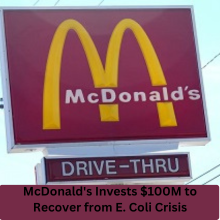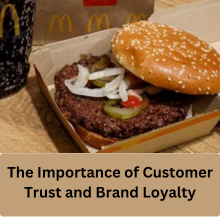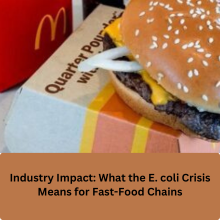
The fast-food giant McDonald’s has faced a significant challenge in the wake of an E. coli outbreak that was linked to its Quarter Pounder burgers. The outbreak affected more than 100 people across 14 states, causing both health concerns and a major dip in sales. In response, McDonald’s has committed to a $100 million recovery plan to regain customer trust and boost its restaurant sales.
This article will dive into the details of this massive investment, its breakdown, and how McDonald’s is working to restore its brand reputation and customer confidence after the crisis.
The E. coli Outbreak: A Setback for McDonald’s
What Happened: The Source of the Outbreak
The trouble began when health authorities, including the Centers for Disease Control and Prevention (CDC), linked an E. coli outbreak to McDonald’s Quarter Pounders, particularly the slivered onions used in these burgers. The CDC reported that the outbreak led to 104 confirmed cases of E. coli infection, with 37 people hospitalized and one death. The company quickly acted to remove the contaminated onions from its menu, but the damage to its reputation was already done.
The Impact on McDonald’s Sales and Reputation
In the immediate aftermath of the outbreak, McDonald’s saw a significant drop in sales. The announcement from the CDC linking their food to the outbreak caused an immediate and negative reaction from customers. The fast-food chain’s stock also took a hit, with shares falling approximately 7% over the following month. For a company known for its consistency and high customer trust, this crisis presented a serious challenge.
McDonald’s Response: A $100 Million Recovery Plan
Breakdown of the $100 Million Investment
In order to recover from the crisis, McDonald’s announced it would invest $100 million into recovery efforts. This fund is being allocated in two key areas: supporting franchisees and driving traffic back to its stores through marketing initiatives.
$65 Million for Franchisee Support
A large portion of this recovery fund, $65 million, is directed toward McDonald’s franchise owners who suffered the most from the outbreak. These franchisees saw a significant drop in sales as customers avoided the affected menu items. The company has specifically targeted those in the hardest-hit states to ensure they receive the financial assistance they need to recover quickly.
$35 Million for Marketing and Promotions
McDonald’s has also allocated $35 million for a comprehensive marketing and promotional campaign. This includes various marketing efforts, such as discounts and special offers, designed to lure customers back into the restaurants. Some of the most notable promotions include a popular $1 McNuggets deal and a $5 meal deal that has been widely successful in the past.
Focus on Local Recovery Efforts
McDonald’s is not only focusing on national marketing efforts but is also implementing local recovery plans in areas most affected by the E. coli outbreak. By customizing recovery strategies for each location, the company hopes to rebuild trust on a more localized level. The full details of these plans are expected to be rolled out in the coming weeks.
The Importance of Customer Trust and Brand Loyalty
McDonald’s History of Building Trust
McDonald’s has spent nearly 70 years building a reputation for delivering consistent, high-quality food. Its iconic Golden Arches are a symbol of trust and reliability in the fast-food industry. However, this E. coli incident threatened to erode much of the trust that McDonald’s had painstakingly built over decades.
How the Outbreak Affected Customer Sentiment
Customer sentiment took a serious hit as news of the outbreak spread. Many people questioned whether the company could be trusted with their health and whether their food was safe to eat. This sentiment was amplified by the growing number of lawsuits filed against the chain. Rebuilding this trust will take time and effort, but McDonald’s is committed to doing so.
Also read: Cardano ADA Surges 70% In Just One Week – Here’s Why
What’s Next for McDonald’s?
The Recovery Phase: What Will Change?
As McDonald’s enters the recovery phase, it plans to continue focusing on food safety and customer well-being. According to a memo from McDonald’s executives, the company will maintain its commitment to doing the right thing by upholding its dedication to safety and transparency. The Quarter Pounders have returned to menus nationwide after extensive testing showed no E. coli in its food.
Strategic Moves in Marketing and Public Relations
Moving forward, McDonald’s will likely place even greater emphasis on food safety in its marketing campaigns. The company’s communications will focus on reassuring customers that their food is safe and that McDonald’s takes every precaution to prevent such incidents in the future.
Industry Impact: What the E. coli Crisis Means for Fast-Food Chains
Competitor Reactions and Market Shifts
McDonald’s competitors have been closely watching the situation. The outbreak has highlighted the importance of food safety in the fast-food industry, and other chains will likely take additional steps to ensure they do not face similar issues. While competitors have not yet made drastic moves, we may see heightened scrutiny and stricter food safety standards across the industry.
The Bigger Picture: Food Safety and Consumer Confidence
This crisis has also had a broader impact on consumer confidence in fast food. While McDonald’s is a global leader, customers are becoming more cautious about where they eat, particularly when it comes to foodborne illness risks. The outbreak underscores the need for restaurants to invest in quality control and transparent communication with customers.
Also read: Bad Sisters Season 2: Anne-Marie Duff Teases Shocking Plot Twists
Conclusion
How McDonald’s Will Bounce Back Stronger
While the E. coli outbreak was a setback for McDonald’s, the company is showing resilience in its recovery efforts. The $100 million investment is a clear indication that McDonald’s is committed to restoring its reputation and ensuring that its customers feel safe and valued. By focusing on both financial support for franchisees and effective marketing campaigns, McDonald’s aims to emerge from this crisis stronger than ever.
What Customers Can Expect Going Forward
Customers can expect more transparency from McDonald’s regarding food safety and more value-driven deals in the coming months. McDonald’s has already reinstated its Quarter Pounder with slivered onions, and the brand will continue to build on its longstanding reputation for quality and safety.
FAQs
What caused the E. coli outbreak at McDonald’s?
The outbreak was linked to slivered onions used in McDonald’s Quarter Pounder burgers. The onions were found to be contaminated with E. coli, leading to illness in over 100 people across 14 states.
How is McDonald’s compensating its affected franchisees?
McDonald’s is investing $65 million into supporting franchise owners who suffered the most from the outbreak. This financial aid will help them recover from lost sales.
How long did McDonald’s suspend the Quarter Pounder with slivered onions?
McDonald’s temporarily removed the Quarter Pounder with slivered onions from menus at some locations during the height of the outbreak. The item has now been reinstated after extensive testing.
Is the food safety issue resolved at McDonald’s?
Yes, according to McDonald’s, the food safety concern has been addressed. No further contamination has been found, and the Quarter Pounder with slivered onions has returned to menus nationwide.
What marketing strategies is McDonald’s using to regain customer trust?
McDonald’s is running several promotions, including discounted McNuggets and meal deals, to entice customers back. Additionally, the company is emphasizing its commitment to food safety in its marketing campaigns.

